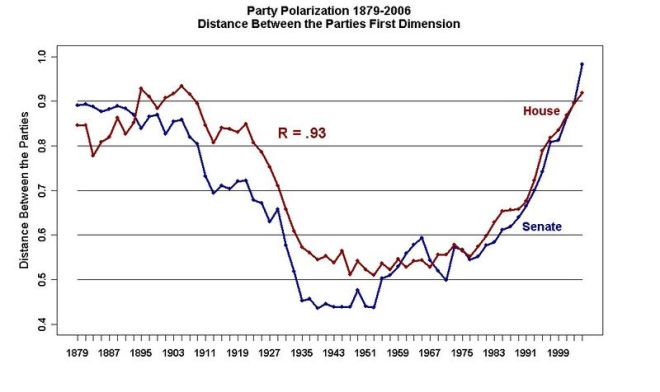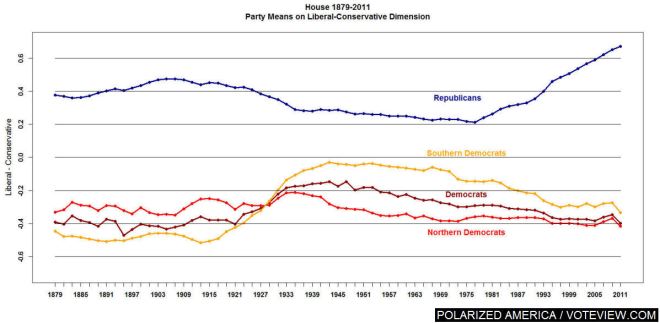By now, it’s obvious to everyone that U.S. political life has become extremely polarized. Not only are lawmakers further and further apart, but the American people are too, geographically and ideologically. Obama famously denied that there’s a red America and blue America, but it turns out he was wrong. There’s red America, a sparsely populated but vast landscape of rural and suburban areas, and there’s blue America, the “urban archipelago” upon which the left’s constituencies — single women, minorities, cosmopolitans — cluster:

Mark Newman, University of Michigan2012 election results, by county
Among the U.S. intelligentsia, polarization is generally seen as an aberration, a problem to be solved with more civility or centrist third parties or procedural reforms. Bemoaning polarization is the favorite indoor sport of Washington VSPs.
The fact is, however, that polarization is the norm in U.S. politics. The bipartisan era was the aberration:
That midcentury era of bipartisanship can be traced almost entirely to America’s system of racial apartheid. There were lots of socially liberal northern Republicans and racist Southern Democrats, which left the parties ideologically scrambled enough that coalitions could be stitched together across party lines. Thus all the momentous legislative achievements of those years, from the Civil Rights Act to the Clean Air Act.
That era is over. Americans and their representatives have sorted themselves ideologically. All Democrats are now to the left of all Republicans, give or take rare and circumstantial exceptions. We have separated into armed camps. (Well, one of the camps is armed anyway.)
But the parties are not mirror images.
The Democratic Party has moved to the left: In 2000, just 29 percent of Democrats self-identified as liberals; by 2013, it was up to 43 percent. But the party, and the left more broadly, remains a motley coalition of interest groups, many frequently at loggerheads with others. There are unions and enviros, single mothers and Catholics and Jews and atheists and gays, immigrants and low-wage workers, bankers and neoliberals and centrists and socialists, climate hawks and coal-state legislators, professors and line workers. It is, as the old cliché goes, like herding cats.
The Republican Party has been moving to the right for much longer, and more steadily. In 2000, 60 percent of Republicans already self-identified as conservatives. By 2013, it was up to 70 percent. (You should read Rick Perlstein’s books about the rise of the right to understand how this happened.)
The civil rights clashes of the ’60s and ’70s, along with the rest of the counter-culture uproar, were the beginning of the end of the bipartisan era. All the new black voters became Democrats and all the racists became Republicans (this was by design, Richard Nixon’s famous “Southern strategy“). The GOP has since defined itself through ressentiment aimed a ceaseless parade of Others — communists, inner-city blacks, godless academics, drug dealers, hippies, homosexuals, slutty women, Muslims, immigrants — all of whom have, sensibly enough, migrated to the Democrats. The GOP is on its way to being a party of Southern white men and their “aggrieved entitlement.” This is not a promising long-term strategy, since old white people have a tendency to die, but given the twisted realities of the U.S. electoral system, it gives them enough power to block everything for years and years to come.
Anyway, partly due to its increasing homogeneity, the right has moved farther to the right than the left has to the left. In fact, the U.S. right has pretty much gone crazy. This is the “asymmetrical polarization” I’m always harping about.
Whatever their relative speeds, though, the two Americas are drifting apart. The forces pushing them are long-term and structural, nothing that can be stymied by daft campaigns like No Labels. Things can always change, of course, and we rarely see the big changes coming. But it’s difficult to envision what sort of exogenous force could arrive in the next decade or two strong enough to reverse the trend.
In short: Polarization is now, and is likely to be for the foreseeable future, a fact of American life.
This is deeply troubling to lots of people, so much so that they deny or ignore it. Even though Mitch McConnell more or less admitted, back in 2010, that the GOP’s strategy was always going to be scorched-earth opposition — as it was from the minute Obama entered office, as it has been, without pause or exception, ever since — pundits still pretend that more “leadership” from Obama could melt Republican resolve. They still pretend that more phone calls, “arm-twisting,” and rousing speeches from Obama could bring people together across the great divide. They still pretend we can meet in the middle.
Because … what if we can’t? What if the divide is unbridgeable and zero-sum politics is what we’re stuck with? If that’s true, then lots and lots of assumptions need to be revisited. Models of institutional and personal behavior that made sense in the era of bipartisanship no longer make sense. The refuge of being a technocratic “problem solver” who is above partisan differences is disappearing. Persuasion is likely to give way entirely to mobilization. Gridlock is the new default.
Nobody relishes the thought of permanent political warfare in which (D) and (R) matter more than facts or evidence — what I’ve called “post-truth politics.” And yet, that’s pretty much what we’ve got. Sooner or later, we have to get beyond grieving. Once we’re past denial and bargaining and on to acceptance, the question then becomes, how do we adjust our behavior? What’s the right way to act in a polarized age? What next?
The question is relevant for virtually everyone involved in American public life, from activists and think tankers to academics, journalists, nonprofit advocacy groups, billionaire donors, lobbyists, lawmakers, and voters. Everyone should be asking themselves: Given that polarization is here to stay, how should I deal with it?
Yet I’ve seen very little concerted thinking on the subject (with one exception, which I’ll discuss tomorrow). There’s plenty of lamentation on the decline of civility and bipartisanship, plenty of pining for the return of comity and wise old Gangs of Six that could transcend differences. But there’s not much serious reflection on how, given the changes in politics, to move forward. Pretending things will go back to the way they used to be is not a strategy.
In the name of nudging that conversation along, I’ll be doing a few posts on it. Stay tuned!





